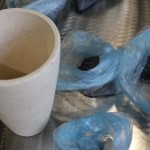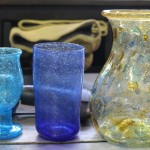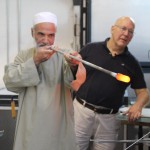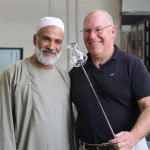The Museum recently hosted a very special guest, Ustad Nasrullah, a glassmaker from Herat, Afghanistan. He, along with The Galleria Kabul Founder Rameen Javid, visited the Museum as part of a U.S. tour, funded in part by a grant through the International Folk Art Alliance in Santa Fe, NM, and New Market Development in Kabul, Afghanistan. The visit was an exciting opportunity for the exchange of glassmaking knowledge, and took us back to the very roots of the art form.
This was not the first time the Museum had worked with someone from the area. In fact, Dr. Robert Brill, the Museum’s Research Scientist Emeritus, helped create the 1977 documentary, Glassmakers of Herat, featuring Mr. Nasrullah’s family. They well may be the last glassmakers on earth making glass in the “old method.”
- Materials Mr. Nasrullah uses to create glass.
- Glass made in Afghanistan by Mr. Nasrullah.
As the film footage shot in 1977 shows, Mr. Nasrullah sits on the ground right at the mouth of the furnace when he works. He uses raw materials collected from the riverbed and desert. His tools are handmade and less than a meter in length, the blowpipe fashioned from the barrel of a gun.
During his trip, his first outside of Afghanistan, Mr. Nasrullah had a chance to work with Bill Gudenrath, the resident advisor of The Studio, and together they blended their knowledge and technique to create glass.
“Everything must have felt utterly foreign to him,” Gudenrath said, whose work station at The Studio is set up in a contemporary Venetian style. Gudenrath made several pieces, even incorporating Mr. Nasrullah’s raw materials to add color. Although Gudenrath encouraged Mr. Nasrullah to “have a go at it,” he was hesitant at first to do more than watch.
- Mr. Nasrullah works with Bill Gudenrath to create glass.
- The finished product.
“Somehow, though, spontaneously we began working together, sharing tasks,” Gudenrath said. “I would gather and marver, he would take over for the blowing. I executed the transfer to the punty, he opened the vessel and then decorated it with hot trails of glass freshly gathered by himself. Let me tell you, that was a magical moment—suddenly, we were in Afghanistan, it seemed. It was certainly an experience of a lifetime for me, and it was clear he enjoyed it, too.”
Mr. Nasrullah later met with Dr. Brill, whom he remembered seeing as a child during the documentary filming. They watched the film together, reminisced about the experience, and discussed the state of glassmaking in Herat today. Since his last visit to Herat in 1993, Dr. Brill had tried many times to contact the family, but had been unsuccessful, so he and many other Museum staff members were excited to learn the rest of the story.
Dr. Marvin Bolt, curator of science & technology, told Mr. Nasrullah that it was an honor to spend time with him. “This is one of the most fascinating things many of us have done in our careers,” he said. “You are connecting us with the traditional ways of a process that has been going on for 2,000 years.”
It is the hope that Mr. Nasrullah will be able to incorporate some of what he learned in the U.S. at his home kiln in Herat.
Watch the Glassmakers of Herat video:





9 comments » Write a comment